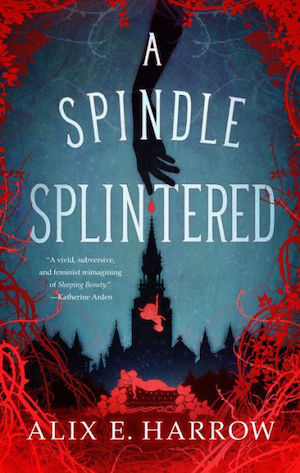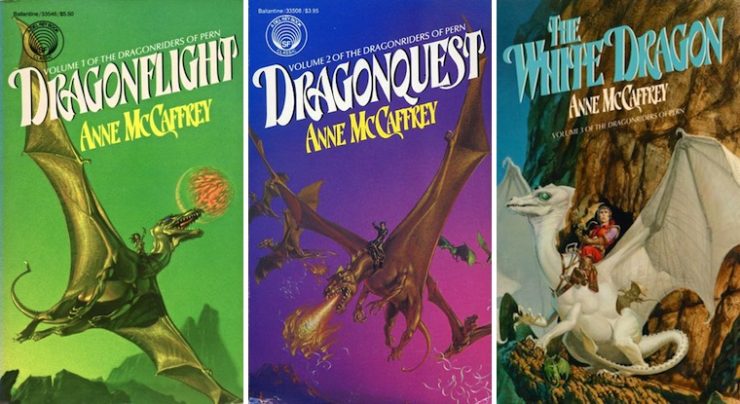I’ve talked before about how Anne McCaffrey modeled her famous dragons on horses, and specifically the Lipizzan horses of the Spanish Riding School of Vienna. What I hadn’t done at that time was sit down and do a reread of a bunch of dragon books.
Recently I got the urge. There happened to be an eBook sale, one of those short-term grab ’em with the first volume deals, and I was looking for some high-quality work avoidance. Bonus chance to find out if I remembered the horseness of dragons correctly? Bring it on.
I managed to get through quite a few volumes before I really had to stop avoiding and start working. I even read a collaboration or two. It was a marathon reading session for the ages, and it was a grand time while it lasted.
The upshot, for the purposes of this series, was that dragons do resemble horses in personality and temperament. Sort of. As for the bond between riders and dragons—more on that in a bit.
Buy the Book


A Spindle Splintered
McCaffrey was a horsewoman herself. She had horses on her farm in Ireland, and she used to joke that we needed to form the SFWA Cavalry, since so many writers in genre were and are horse people. She once said in my hearing that Lessa was based on a woman she knew who rode racehorses: a fierce, tiny, dark-haired person riding large, headstrong, opinionated, fast animals.
What interested me when I reread her books was that I could see where and when she came from as a horse person. Her dragons represent a view of horses that I saw a lot of as a child and teenager. They’re loved, admired, celebrated for their power and beauty.
And yet, they have a few limitations. Except for Ruth, the White Dragon, they have no retentive memory. Everything is in the now. Whatever they think or feel today, by tomorrow they’ll have forgotten. It’s Eternal Sunshine of the Spotless Mind with telepathy and teleportation.
That’s old horseman’s wisdom, that horses live in the perpetual present. It makes no allowance for what so often happens in training, that something bad happened once and the horse will never go to the place or do the thing again without melting down. Horses can remember people and actions from years back, and will retain bits of training for a decade or more.
I can testify to that from my habit of ending up with late-teenaged rescue horses who haven’t been ridden in years, but who, once saddled up, seem not to have forgotten a thing. Give me a seventeen-year-old green bean with a good start along about age six, and with a little time to polish off the rust, I’ll end up with a nice riding horse who enjoys their work. It’s a pleasure to ride these horses: They’re old enough to have lost the young-horse silliness, but young enough to still have a good number of riding years left. Especially if they’ve been broodmares, they really seem to appreciate the change of career. They’ve done the mommy track; now they’re ready to get out and see the world.
Still, for the time she lived in, and what horse people of that time thought horses were capable of, McCaffrey is fairly on point with her dragons and their mental capacity. She certainly captures the individuality of each separate dragon, especially the queens—and the way the males, bronzes and browns notably, defer to their ladies. Myth and legend notwithstanding, it’s the mares who rule, and smart stallions are well aware of it.
The thing that captivates readers the most about dragons, or at least this reader, is the way dragons and riders are joined in a lifelong, soul-deep bond. It begins with Impression, when the dragon is first hatched. It nearly always ends when the rider dies and the dragon goes between and never comes back. If by rare misfortune the dragon dies first, the rider either suicides soon after, or lives out their life as half a person.
It’s not usually that extreme when horse and rider are bonded, but it can be pretty intense. Nor is it only horses. Anyone who has had a true animal companion—soul dog, heart cat—knows what it’s like.
McCaffrey captures that really well. It’s the whole point of her series, above and beyond the romance and adventure. The core of her world is that connection. The world wouldn’t survive without it—literally. Dragons and riders fight Thread, which otherwise would strip Pern of life.
Of course as the series goes on, the people of Pern discover and rediscover other, less dramatic ways to get the job done, and eventually eliminate the threat altogether. But dragons continue to be essential to the way the world works, just as horses on Earth have shifted from transport and war machines to companion animals. Earth wouldn’t be quite the same without horses, and human-occupied Pern is defined by the presence of dragons.
The one thing I wanted to thump McCaffrey for was almost a throwaway in Dragonsdawn. The people who will become the first Weyrleader and Weyrwoman get their start as horse trainers. Horses are their passion. But as soon as they get into dragons, they drop the horses cold.
I get that, I do. Dragons are much bigger and fancier than horses. On Pern, they’re the crazy idea that saves the world. Caring for them is a full-time occupation, literally eating up every hour of every day.
Nevertheless. As a horse person, I’m a little bit miffed by that. Like the kid who dumps their pony because someone gives them a fancy big Thoroughbred, these not-much-older people go all in on the hot! new! thing!
I think it bothers me because Sean’s stallion is, until the dragons come along, his heart and soul. He gave up a great deal for that horse, and invested so much of himself. And yet he walks away.
I feel for the horse more than for the human. It just seems that Sean could have made more effort to work out a compromise.
But that’s me. I’ve seen plenty of people do what Sean does. People outgrow their ponies. They move up through levels of competition, and trade up horses as they go. If the ultimate trade-up was a dragon, I don’t think many of them would hesitate.
It says a lot for McCaffrey’s powers as a storyteller that she can evoke this response. Her work is far from perfect, but it hits the spot in so many ways. I had a grand time reading and rereading my way through the saga. Jaxom and Ruth especially—I know how it feels to be bonded to a little white wonderbeast, though unlike Jaxom and too much like Lytol, I had to outlive him.
McCaffrey was horse people. She understood.
Judith Tarr is a lifelong horse person. She supports her habit by writing works of fantasy and science fiction as well as historical novels, many of which have been published as ebooks. She’s written a primer for writers who want to write about horses: Writing Horses: The Fine Art of Getting It Right. She lives near Tucson, Arizona with a herd of Lipizzans, a clowder of cats, and a blue-eyed dog.










